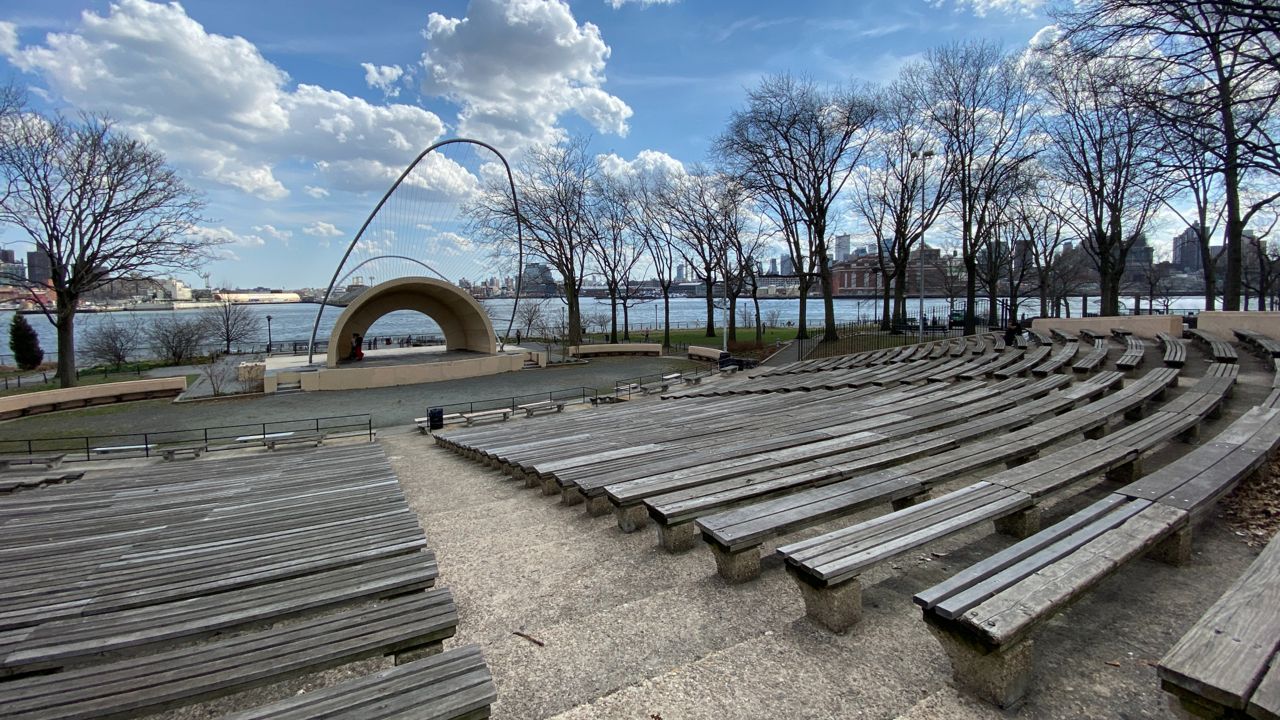Every other day, Sally Heckel runs along the waterfront in East River Park for about 20 minutes. Afterwards, she often takes pictures of flowers and shrubs on her phone, documenting the changing seasons through the park’s native flora.
“It keeps me sane, and makes me happy,” Heckel, a filmmaker and 40-year resident of the Lower East Side, said on a recent overcast day in the park. “No matter how bad anything is, weather, anything, I have to run.”
Soon, however, Heckle’s lifeline is going to be disrupted: To combat sea level rise and worsening storm surges brought on by climate change, the park is getting totally rebuilt.
“They have to lift it up, so they have to destroy it to do that,” she said.
This summer, construction will start on what the city is calling the East Side Coastal Resiliency Construction: Over five years, moving in two phases, East River Park will be razed and rebuilt on eight feet of soil.
What You Need To Know
- About half of East River Park will close this spring to begin a construction project that will raise the park by eight feet.
- The project, the first of its kind in the country, will help protect the park and the Two Bridges neighborhood, from flooding during storms and due to sea level rise.
- Proponents of the plan laud the major investment in a neighborhood with thousands of public housing units.
- Some local residents feel that the plan unfairly limits access to the park when residents need it most, and are concerned the project will not be finished in time.
The city hopes that a taller park will protect the public housing that runs its length from the kind of flooding, caused by Superstorm Sandy in 2012, that left some residents without electricity and running water for months.
Opponents of the plan include a local resident activist group and the ecology center that collects food scraps from across the borough and uses a lot in the park to create compost for consumers and the city. They feel that there have been grave transparency issues around the city’s construction plan, and argue that any plan that disrupts resident access to the park, especially in the aftermath of a pandemic that forced residents inside for months on end, is irresponsible and unhealthy.
But people who support the plan say it represents something rare in New York City: a $1.45 billion investment to protect a low-income community and their cherished open space. The residents may lose the park they grew up with, proponents say, but with a plan that calls for more than a mere floodwall, they’ll gain a park that could be impervious to sea level rise through the next several decades.
“If we built resilience measures, and didn’t protect the park itself, we would continue failing our communities for the exact reason the environmental justice movement started,” said Carlina Rivera, the City Council member who has represented the area since 2018. “My community doesn't deserve a park that essentially turns into a bathtub every few years when there's a hurricane. We deserve a park that's protected."
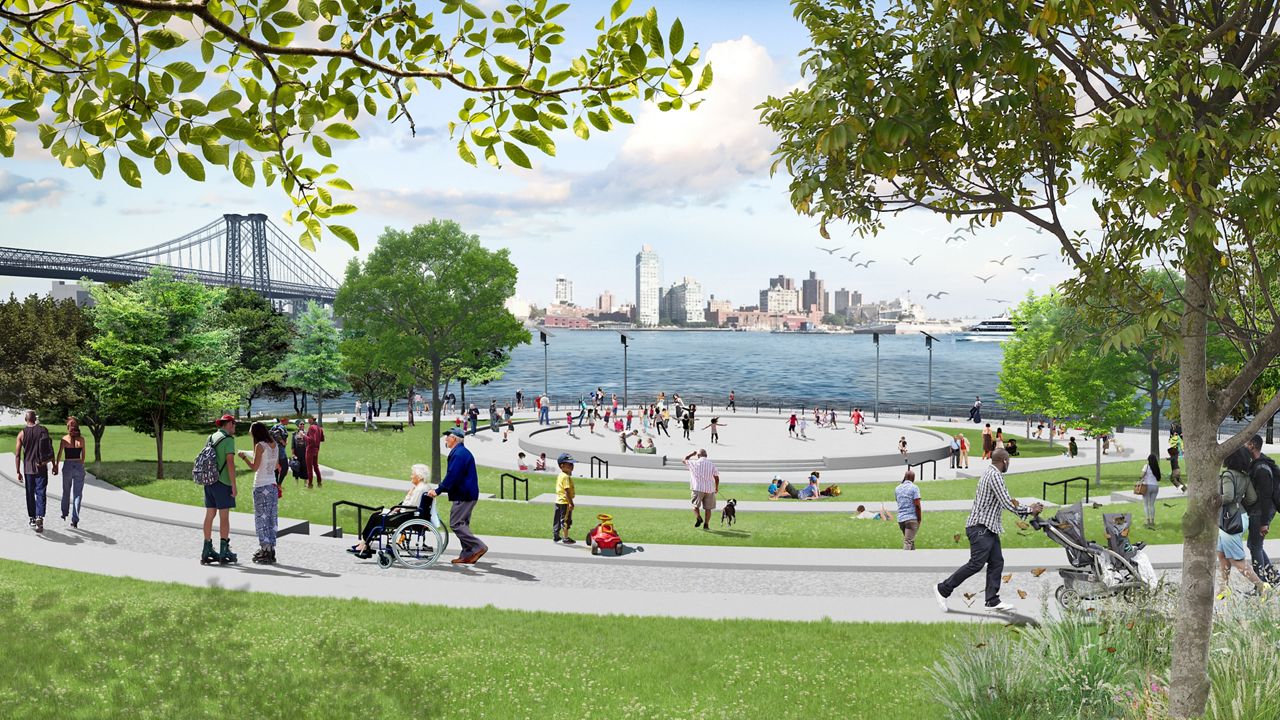
What to expect from construction
The construction is set to happen in two phases, and the city has promised that at least 42% of the park will be usable at any time. The completion date for the project is 2025, 13 years after Superstorm Sandy.
The original plan for the park leaned all its flood protection on a wall and levee system that ran alongside FDR Drive, on the western edge of the park. That plan would have required closing a lane of the highway, forcing construction crews to work, and perform the noisy process of pile driving, at night, across the street from NYCHA buildings with thousands of residents.
The new plan puts the wall out of view, underneath much of the park. The wall, sandwiched between two massive infills of a million tons of soil, runs underneath the new track, a full size soccer field and other courts and lawns that will be built.
The entire East River resiliency effort has been split into two broad project areas. A construction company has already begun work on Asser Levy Park, above Peter Cooper Village on 23rd Street, and is constructing a floodwall there.
The city has received two bids for the remaking of East River Park, both tens of millions of dollars over the projected cost of construction, and is still in the process of choosing which bid to accept.
Barring changes made by the contractor, construction will begin in late-spring of this year, said Ian Michaels, a spokesman for the city’s Department of Design and Construction.
Construction will close off the stretch of the park that runs from East Houston Street to East 10th Street, and most of the park from Delancey Street to Montgomery Street. The construction will cut off bike and other access to the East River Greenway, forcing riders, walkers and runners back into the city from 13th Street to Pier 42, at Montgomery Street.
That will leave the park’s tennis and basketball courts and several lawns around the Williamsburg Bridge, as well as the playground by East 10th Street, open for now. Midway through construction, those areas will close, and the park’s rebuilt baseball fields and track will reopen.
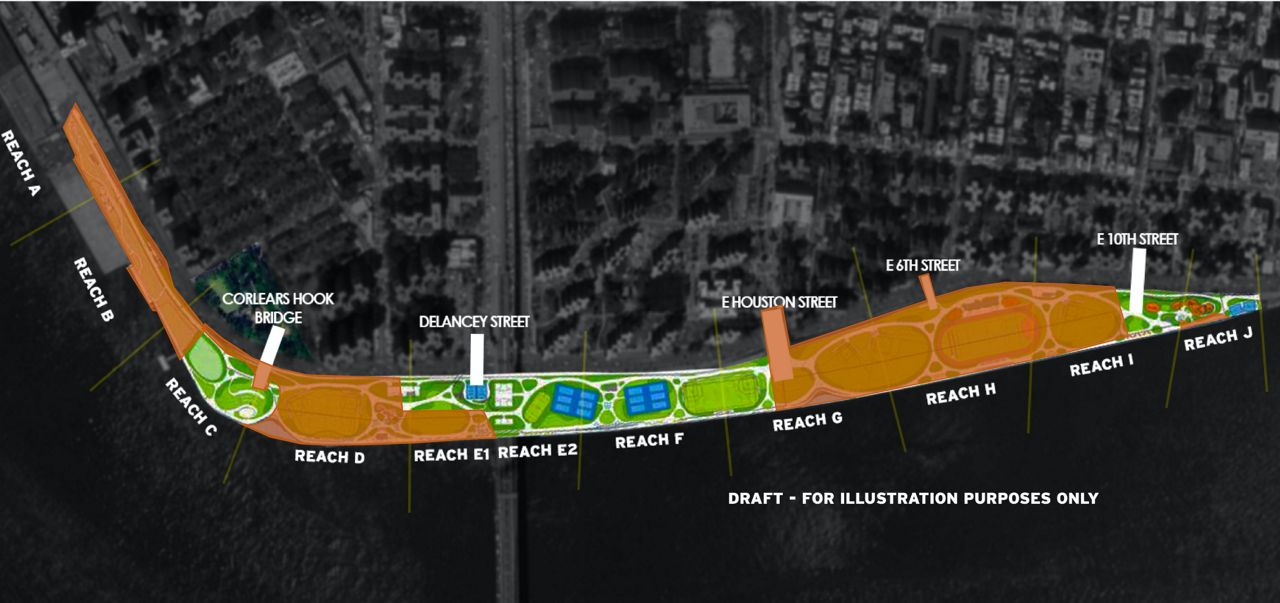
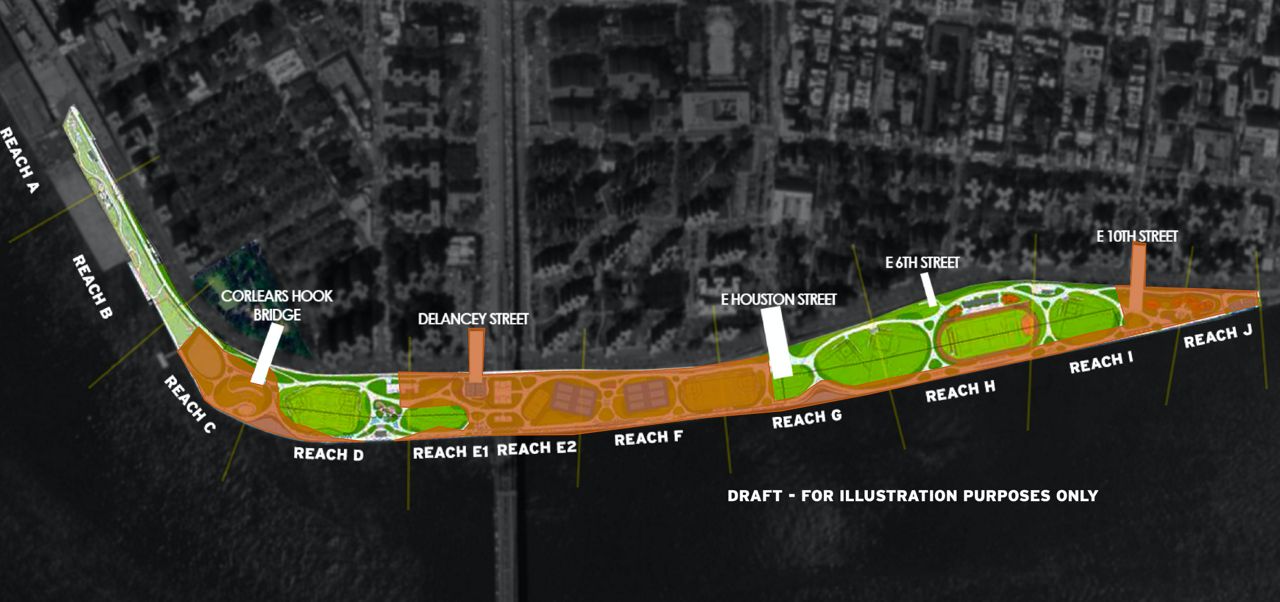
The closures are already affecting youth sports. The city has told the local LES-OLS Little League that starting June 1 it will only have access to two out of the park’s eight fields, forcing it to use fields elsewhere in Manhattan.
“That’s hardly how we'd like to run our community program,” said Tony Rivera, the league president.
‘It’s a major disruption’
Rivera is part of a faction of residents who opposes the project, concerned that the city will drag out construction, leading to air pollution caused by soil drifting off the million tons of dirt that will be used to raise the park. He feels that the loss of six of eight ballfields, when the city had said that about half the park would be open throughout construction, is a bad omen, and is worried that ten years could pass without a completed park, affecting multiple generations of Little League athletes.
“If they couldn't deliver on the easy stuff, what confidence do you get on the rest of it?” he said.
The plan has drawn opposition from other local and activist groups, such as the Warriors in the Garden, a protest organizing collective.
The construction is also going to be a major disruption for the Lower East Side Ecology Center, which has been the East River Park’s main steward for more than 20 years, planting and maintaining much of the park’s flowers and shrubs.
The Center also uses a lot near Pier 42 to process the more than 15,000 pounds of food scraps it collects from Manhattan households, and runs classes and educational programs from the historic Fire Boat House in the park, near Delancey Street.
The construction will require the Center to leave the Fire Boat House, where its administrative offices are. The Parks Department has given the Center space in nearby Seward Park to run its classes.
“It’s a major disruption,” said Christine Datz-Romero, the Center’s co-founder and executive director. “It’s like a cluster bomb. We’re going to be dispersed in all different directions.” CUT
“I feel that they’re using ESCR to kick us out of parks permanently,” she added.
In an emailed statement, Crystal Howard, a spokesperson for the Parks Department, wrote that the department is “committed to good faith negotiations” over the Center’s future in the park, and that the Center has put off moving their operations to Seward Park, “which impedes our moving forward to discuss their future at East River Park.”
East River Park Action, a group of local tenants, is also opposing the plan. The park, they say, has been a lifeline to residents throughout the pandemic, and it is necessary for physical and mental healing in the wake of COVID-19. The fear that destroying a park that many residents grew up with, as well, with its barbecue areas and famous amphitheater, could be emotionally disturbing and culturally disruptive.
“For them to just take all of that away, it’s really detrimental to the community,” said Fannie Ip, a member of the group who grew up in the neighborhood. “This is where they go for summer vacation. This is our Hamptons.”
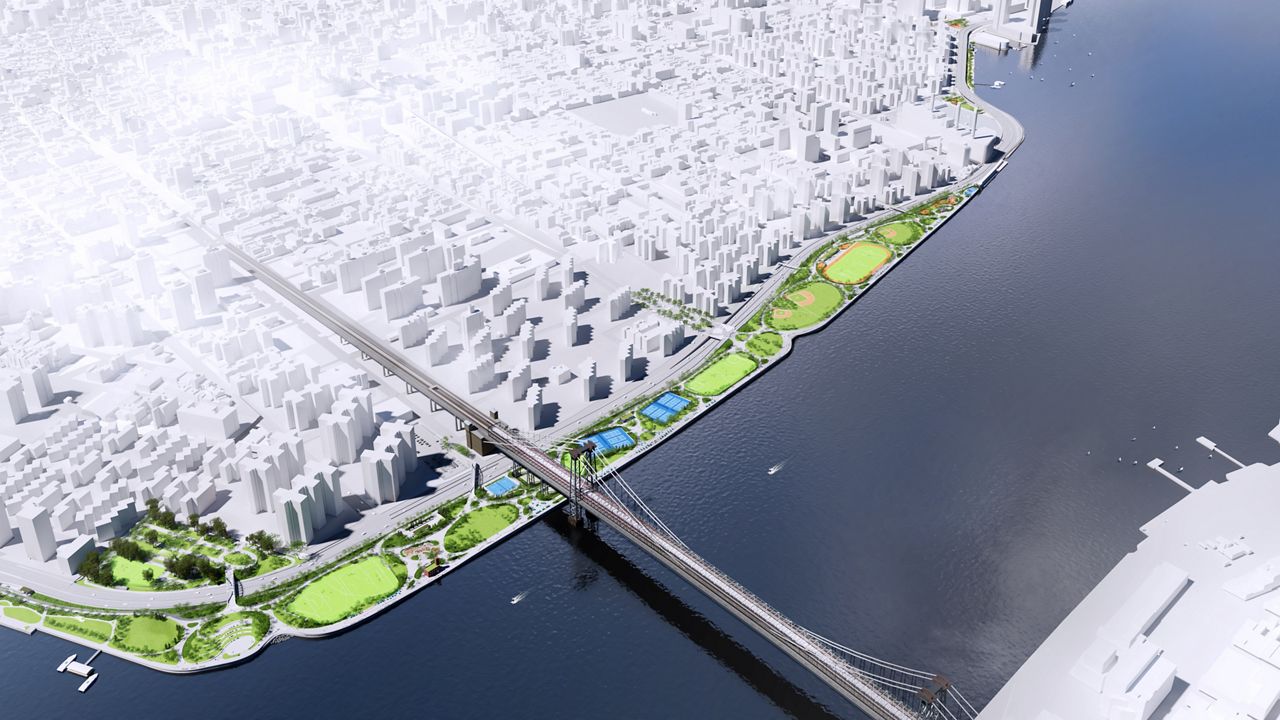
‘A transparency issue’
Ip and others in East River Park Action are now most of all concerned with how transparent the city has been with its plans. The group is engaged in an ongoing legal legal battle with the city over a major report that the city used to revise its construction plan for the park.
The nearly 350-page report, compiled by a firm from Missouri, enumerated dozens of ways the city could save money on the plan, and provided the suggestion that the city raise the entire park and place the floodwall underneath it, instead of trying to build the wall along the highway, and above highly sensitive ConEd electric lines that would have needed to be excavated by hand.
That measure alone, the report concluded, could save the city $319 million.
Yet when the group filed a Freedom of Information Law request for the form, they were initially told it didn’t exist. They appealed, and received the report in a heavily redacted form, with nearly every rendering and advantage-disadvantage column for the cost-saving measures blacked out. The Office of Management and Budget defended the redactions by citing FOIL law that allows government agencies to redact certain inter- or intra-agency material, as well as any information that would be an invasion of personal privacy.
East River Park Action is now suing the city again for the full report, using the more than $35,000 it has raised for the effort.
“This is basically a transparency issue at this point,” Ip said. “This should be a concern for the entire City Council.”
The group has called for a hearing on the report redaction, and feel that Rivera, the Council Member, has let the community down by not pushing City Hall harder.
On February 12, Rivera sent a letter to Mayor Bill de Blasio asking him to unredact more material from the report. While she said the city can improve in its communication with community members, she declined an offer to join East River Park Action’s FOIL lawsuit.
“I want to wait and hear back from the city first, and their response to my letter,” Rivera said. “If they can respond to my demand and release that information, that is a big win for the community and for the advocates.”
The national environtmental group the Sierra Club also called the city out over the redactions in a February letter, highlighting the lack of information about what soil or substance would be used to fill in the park. A portion of the report that is not redacted notes that, given the large quantity of fill used in the project, it would be "difficult to source." The Club said it was concerned that the difficulty with sourcing might lead to the fill containing "toxins with devastating long term health effects on children who will play in the park."
"The secrecy, inadequacy, and sequence of events and information releases have left many perplexed and disturbed," the club wrote.
Ip is concerned that by hiding much of the report, the city is hiding possible alternatives for East River Park that could prevent flooding without destroying the park as it is.
“That’s how they've been dividing us: if you want flood protection, this is it,” Ip said.”But that's false. This is not the only plan.”
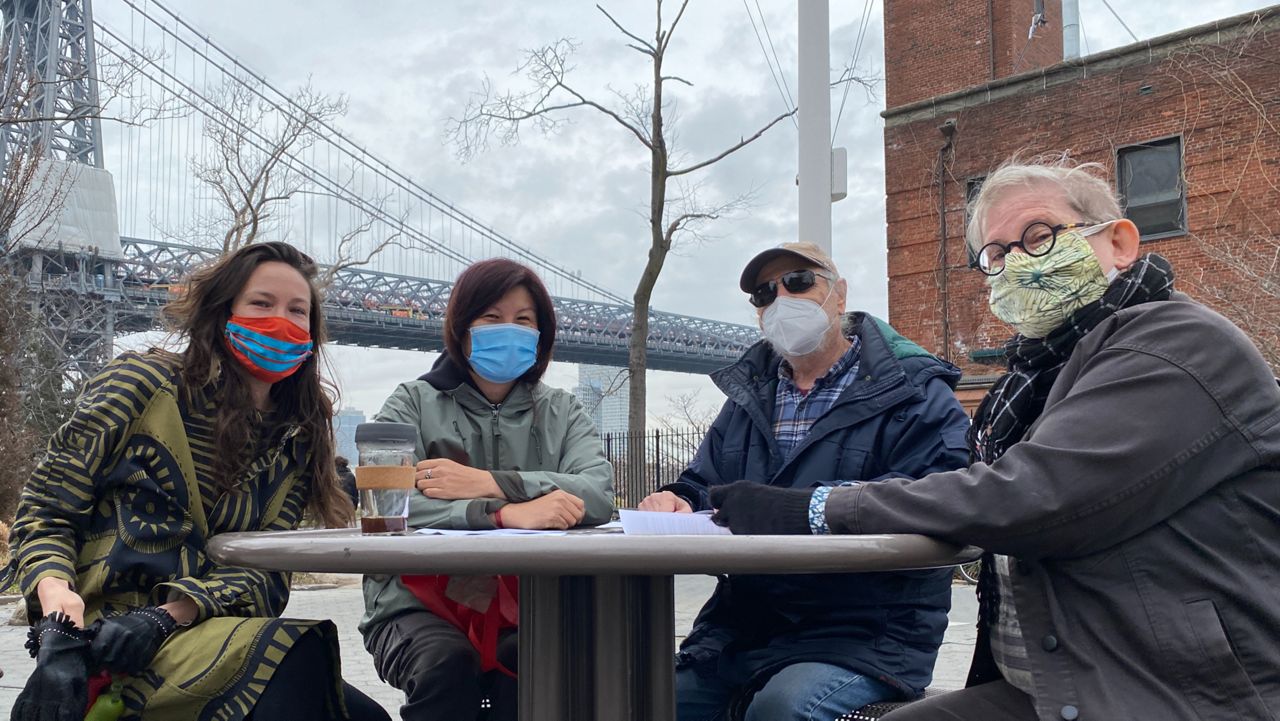
‘Construction after construction after construction’
There have been other visions proposed for the park throughout the past decade. Members of East River Park Action say they had hoped that the plan might incorporate wetlands along Manhattan’s coast that could stop encroaching flood waters, or that the city would pursue a multi-billion-dollar decking-over of the FDR Drive, dramatically expanding open space on the waterfront.
The new height of the park, at eight feet, may also only hold for a period of a few decades. Recent scientific studies suggest that global sea levels are rising more quickly than predicted by the international climate change reports on which the city relied to determine that eight feet would be a sufficient height to prevent storm surges.
Johannes Gehreis, an engineer with Deltares, the Dutch research institute that studies coastal areas and waterways, concluded in an independent report that the city should increase the fill height to ten feet. Rivera and Manhattan Borough President Gale Brewer commissioned Gehreis’ report, which was released in 2019.
Yet Trever Holland, who chairs Community Board 3’s Parks Committee, said that he believes this plan, while not being ideal, is the best plan for the moment, though he also faults the city for the transparency issues around the redacted report.
“The community board felt that this was the best decision based on the information we have right now,” he said.
Holland noted that the Board voted down the city’s initial plan, since it would leave the park flooded during severe storms and was developed without community input, and that the community plans to hold the city to account for their promises around the timeline and accessibility of the park throughout construction. The new plan secured the full size soccer field, as well as improvements to other neighborhood parks and more extensive handicap accessibility.
“It may not be a better plan, but it seems on paper that it is,” he said. “Traditionally we do not see large infrastructure projects that are designed to protect neighborhoods like ours.”
For some residents, they are not sad to say farewell to the current park, which has spent much of its life with one part or another closed for renovation or construction.
“It used to be a banana peel, then it was a parking lot, then it was a dirt fill,” said Nanzy Ortiz, the former president of the Vladeck Houses, a nearby NYCHA development. “That park has gone through construction after construction after construction, so I don't understand what the big deal is.”
Ortiz said she is in particular looking forward to handicap accessibility at Delancey Street, where the current bridge’s grade effectively precludes wheelchair-bound people, or those who use walkers, from getting across the highway into the park.
“How great it would be to be able to cross the street,” she said. “I’m getting up there in age. When my grandchildren gotta push me, I don't want them to have to push me too far.”
Holland acknowledges the difficult choice to tear up the park to save it. But, he says, theirs is not the only area that will lose some access to their waterfront: A firm tasked with redesigning the Battery Wharf to prevent flooding unveiled their plan earlier this month, which will require raising the park near the water by five feet.
“This is not the only tough choice we’re gonna have to make,” Holland said. “Everyone is trying to fight the water that we know is coming.”
